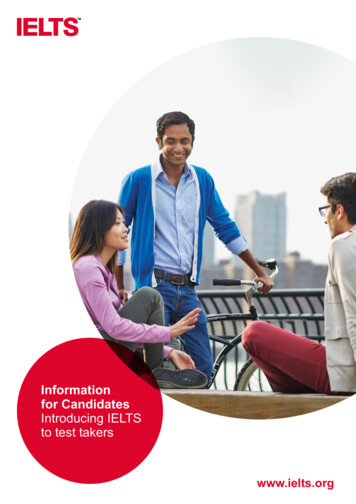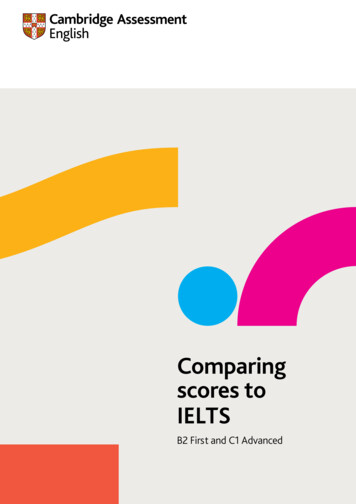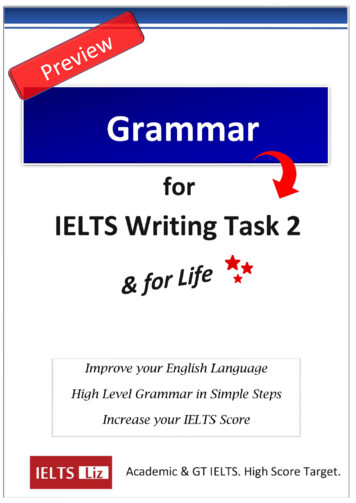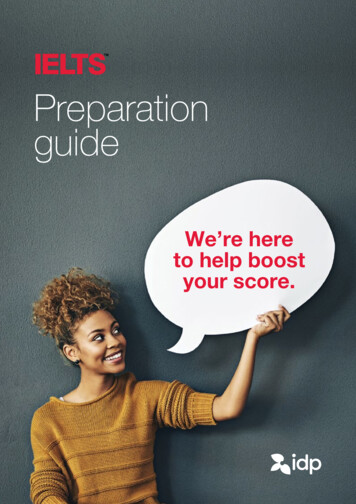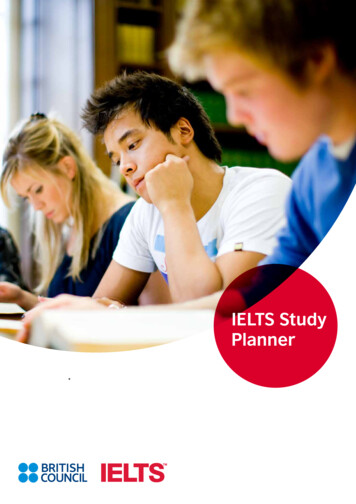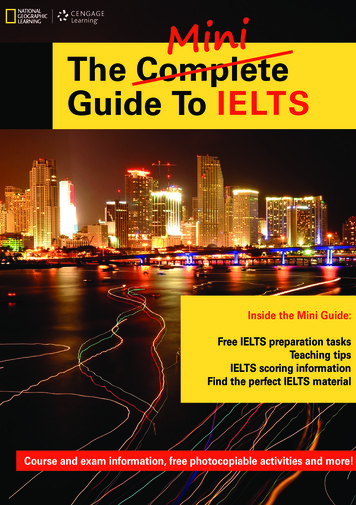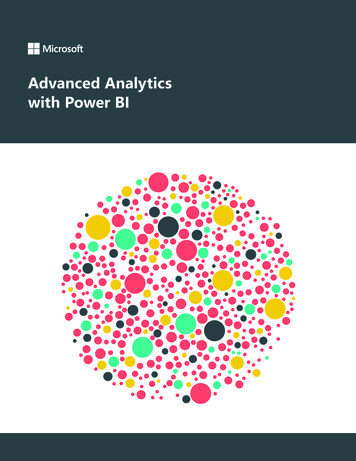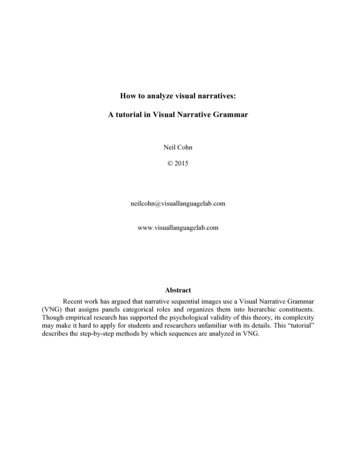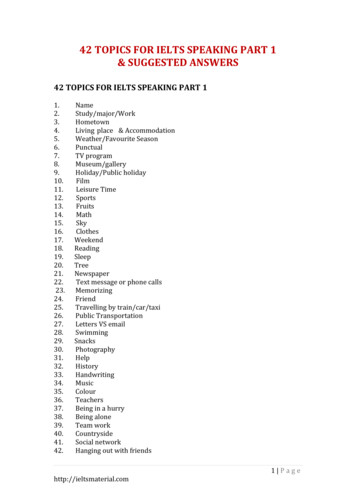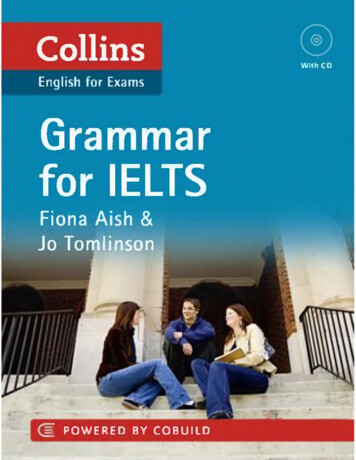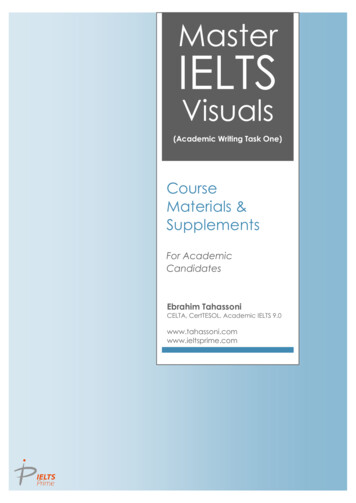
Transcription
MasterIELTSVisuals(Academic Writing Task One)CourseMaterials &SupplementsFor AcademicCandidatesEbrahim TahassoniCELTA, CertTESOL, Academic IELTS 9.0www.tahassoni.comwww.ieltsprime.com
Master IELTS VisualsAcademic Writing Task 1By Ebrahim TahassoniCambridge CELTA (Pass B) , Sussex Downs CertTESOL (Merit), IELTS Academic 9.0,Level 3 Certificate in English, Trained for teaching IELTS courses by IDP Australia &Sussex Downs CollegeSixth Edition (ver. 6.10.11)December 2020In compliance with IELTS assessment criteria, Cambridge model answers, and IDP teaching guidelinesDownloaded from www.tahassoni.comUse our IELTS writing assessment service! Visitwww.ieltsprime.com/ieltswriting
Master IELTS Visuals Ebrahim Tahassoniwww.tahassoni.com Telegram: www.t.me/ielts primePage 1
Master IELTS Visuals Ebrahim TahassoniIntroductionUnderstanding the RubricWRITING TASK 1You should spend about 20 minutes on this task.The charts below give information about world spending and population.Summarise the information by selecting and reporting the main features, and make comparisonswhere relevant.Write at least 150 words.The TaskTask 1 involves reporting the data in a visual item or collection of data such as a table. Youhave to: Summarise the information in the visual or set of data: Select the main features Report the main featuresMake comparisons were relevantwrite at least 150 words at least 165-170 words (sometimes even more words arenecessary to cover the main features of more detailed diagrams)Note: Finish task 2 first before addressing task 1. Task 2 has twice as many marks as task 1 andis less flexible in terms of coherence and paragraphing, so if you do not get around tofinishing it, you may lose more marks than when you leave task 1 unfinished.The Answer SheetYou will receive separate answer sheets for tasks 1 and 2, and the one for task 1 has redborders. Although you may ask for extra sheets to write your answer in, this is not likely tobecome necessary since the space you are already provided with is way more than sufficient.You must not write in the blank space at the bottom of the first page or in the scoring section atthe bottom of page two. A copy of the answer sheet is available at the end of this coursepack.www.tahassoni.com Telegram: www.t.me/ielts primePage 2
Master IELTS Visuals Ebrahim TahassoniTask Types1. Data driven diagramsa. Comparison tasksb. Trend tasksNon-data driven diagramsa. Process diagramswww.tahassoni.com Telegram: www.t.me/ielts primePage 3
Master IELTS Visuals Ebrahim Tahassonib. MapsMixed Taskswww.tahassoni.com Telegram: www.t.me/ielts primePage 4
Master IELTS Visuals Ebrahim TahassoniAssessment CriteriaEvery report is read four times by an examiner and each time, it will be marked on one of the followingcriteria: Task Achievement (TA) Coherence and Cohesion (CC) Lexical Resource (LR) Grammatical Range and Accuracy (GRA)Task Achievement (TA)This criterion assesses how appropriately, accurately and relevantly the response fulfils therequirements set out in the task, using the minimum of 150 words.Academic Writing Task 1 is a writing task which has a defined input and a largely predictableoutput. It is basically an information-transfer task which relates narrowly to the factual contentof the input data or diagram and NOT to speculated explanations that lie outside the provideddiagram or data.The examiner has the following questions in mind when assessing this aspect of your report:1. Have you summarised the information appropriately by selecting and properly reportingthe main features?2. Have you made comparisons properly and sufficiently?3. Have you provided overviews of the main trends/comparisons/stages?4. Have you written a clear overview or summary for the report?Coherence and Cohesion (CC)This criterion is concerned with the overall clarity and fluency of the message: how the responseorganises and links information, ideas and language. Coherence refers to the linking of ideasthrough logical sequencing. Cohesion refers to the varied and appropriate use of cohesivedevices (for example, logical connectors, pronouns and conjunctions) to assist in making theconceptual and referential relationships between and within sentences clear.The examiner has the following questions in mind when assessing this aspect of your report:5.6.7.8.9.Have you organised your information logically?Is there an overall flow or progression in your report?Have you used linkers correctly, properly and sufficiently?Have pronouns been used correctly and do they have clear references?Have you organised the text in paragraphs logically and sufficiently?www.tahassoni.com Telegram: www.t.me/ielts primePage 5
Master IELTS Visuals Ebrahim TahassoniLexical Resource (LR)This criterion refers to the range of vocabulary the candidate has used and the accuracy andappropriacy of that use in terms of the specific task.The examiner takes the following points into account when assessing this aspect of your report:1. Wordsa. Range and flexibilityb. Levelc. Precisiond. Stylee. Collocation2. Vocabulary mistakesa. Spellingb. Word choicec. Word formationNote: when evaluating mistakes, the effect each has on the reader and the intelligibility of yourreport is taken into account.Grammatical Range and Accuracy (GRA)This criterion refers to the range and accurate use of the candidate’s grammatical resource asmanifested in the candidate’s writing at the sentence level.The examiner has the following questions in mind when assessing this aspect of your report:1. Have you used a variety of sentence structures?2. How often have you used compound structures?3. Mistakesa. Grammarb. PunctuationNote: when evaluating mistakes, the effect each has on the reader and the intelligibility of yourreport is taken into account.www.tahassoni.com Telegram: www.t.me/ielts primePage 6
Master IELTS Visuals Ebrahim TahassoniIELTS Task 1 Writing Band Descriptors (Public Version)Band9Task Achievement 8 fully satisfies all therequirements of thetaskclearly presents afully developedresponse covers allrequirements of thetask sufficientlypresents, highlightsand illustrates keyfeatures/ bulletpoints clearly andappropriately Coherence andCohesionuses cohesion insuch a way that itattracts no attentionskilfully managesparagraphingsequencesinformation andideas logicallymanages allaspects of cohesionwelluses paragraphingsufficiently andappropriatelyLexical Resource 7 6 covers therequirements of thetask(Academic) presentsa clear overview ofmain trends,differences or stages(General Training)presents a clearpurpose, with thetone consistent andappropriateclearly presents andhighlights keyfeatures/bullet pointsbut could be morefully extendedaddresses therequirements of thetask(Academic) presentsan overview withinformationappropriatelyselected(General Training)presents a purposethat is generallyclear; there may beinconsistencies intonepresents andadequatelyhighlights keyfeatures/ bulletpoints but detailsmay be irrelevant,inappropriate orinaccurate logically organisesinformation andideas; there is clearprogressionthroughoutuses a range ofcohesive devicesappropriatelyalthough there maybe some under/over-use arrangesinformation andideas coherentlyand there is a clearoverall progressionuses cohesivedevices effectively,but cohesion withinand/or betweensentences may befaulty ormechanicalmay not always usereferencing clearlyor appropriately uses a wide range ofvocabulary with verynatural andsophisticated controlof lexical features;rare minor errorsoccur only as ‘slipsuses a wide range ofvocabulary fluentlyand flexibly toconvey precisemeaningsskilfully usesuncommon lexicalitems but there maybe occasionalinaccuracies in wordchoice andcollocationproduces rare errorsin spelling and/orword formationuses a sufficientrange of vocabularyto allow someflexibility andprecisionuses less commonlexical items withsome awareness ofstyle and collocationmay produceoccasional errors inword choice, spellingand/or wordformationuses an adequaterange of vocabularyfor the taskattempts to use lesscommon vocabularybut with someinaccuracymakes some errors inspelling and/or wordformation, but theydo not impedecommunicationwww.tahassoni.com Telegram: www.t.me/ielts primeGrammatical Range andAccuracy uses a wide range ofstructures with fullflexibility andaccuracy; rare minorerrors occur only as‘slips’ uses a wide range ofstructuresthe majority ofsentences are errorfreemakes only veryoccasional errors orinappropriaciesuses a variety ofcomplex structuresproduces frequenterror-free sentenceshas good control ofgrammar andpunctuation but maymake a few errorsuses a mix of simpleand complexsentence formsmakes some errors ingrammar andpunctuation but theyrarely reducecommunicationPage 7
Master IELTS Visuals Ebrahim Tahassoni 5 4 3 generally addressesthe task; the formatmay be inappropriatein places(Academic) recountsdetail mechanicallywith no clearoverview; there maybe no data to supportthe description(General Training)may present apurpose for the letterthat is unclear attimes; the tone maybe variable andsometimesinappropriatepresents, butinadequately covers,key features/ bulletpoints; there may bea tendency to focuson detailsattempts to addressthe task but does notcover all keyfeatures/bullet points;the format may beinappropriate(General Training) failsto clearly explain thepurpose of the letter;the tone may beinappropriatemay confuse keyfeatures/bullet pointswith detail; parts maybe unclear, irrelevant,repetitive orinaccuratefails to address thetask, which may havebeen completelymisunderstoodpresents limited ideaswhich may be largelyirrelevant/repetitive presents informationwith someorganisation but theremay be a lack ofoverall progressionmakes inadequate,inaccurate or overuse of cohesivedevicesmay be repetitivebecause of lack ofreferencing andsubstitution presents informationand ideas but theseare not arrangedcoherently and thereis no clear progressionin the responseuses some basiccohesive devices butthese may beinaccurate orrepetitive does not organiseideas logicallymay use a verylimited range ofcohesive devices,and those used maynot indicate a logicalrelationship betweenideashas very little controlof organisationalfeatures 2 answer is barelyrelated to the task1 0 answer is completely fails to communicateunrelated to the taskany messagedoes not attenddoes not attempt the task in any waywrites a totally memorised responsedoes not attempt the task in any waywrites a totally memorised response uses a limited rangeof vocabulary, butthis is minimallyadequate for the taskmay makenoticeable errors inspelling and/or wordformation that maycause some difficultyfor the reader uses only basicvocabulary whichmay be usedrepetitively or whichmay beinappropriate for thetaskhas limited control ofword formationand/or spelling; errorsmay cause strain forthe reader uses only a verylimited range ofwords andexpressions with verylimited control ofword formationand/or spellingerrors may severelydistort the messageuses an extremelylimited range ofvocabulary;essentially no controlof word formationand/or spellingcan only use a fewisolated words attempts sentenceforms but errors ingrammar andpunctuationpredominate anddistort the meaning cannot use sentenceforms except inmemorised phrases cannot use sentenceforms at allwww.tahassoni.com Telegram: www.t.me/ielts prime uses only a limitedrange of structuresattempts complexsentences but thesetend to be lessaccurate than simplesentencesmay make frequentgrammatical errorsand punctuationmay be faulty; errorscan cause somedifficulty for thereaderuses only a verylimited range ofstructures with onlyrare use ofsubordinate clausessome structures areaccurate but errorspredominate, andpunctuation is oftenfaultyPage 8
Master IELTS Visuals Ebrahim TahassoniSection 1ComparisonDiagramswww.tahassoni.com Telegram: www.t.me/ielts primePage 9
Master IELTS Visuals Ebrahim TahassoniComparison LanguageA. Introducing DifferencesGenerally, there isa significant differencebetween a and b.a wide disparityin n.B. Comparative Structuresby x.1In contrast (to A),In comparison (with A)2A is3A is [under/over]4A isconsiderably/substantiallymarginally/slightly5A is[almost/roughly / ]6B is larger/smaller[just] [under/over][approximately]x larger/smaller than B.twicetwo/three timesA produces/consumes/ by a narrow margin.by a margin of x.by a staggering x.as large/great/high as B.greater/higher/smaller than B.as large/high as B.more/less uncountable n.more/fewer countable n.than B.the same amount/number/quantity of n.as B.C. Superlative Structures1A ranks/stands first/second/third/last.2A is the [second/third] largest/smallest/most significant/most productive/ n.3A has the [second/third] greatest/widest/ most significant/most productive/ n.Uses4Aproducesconsumesthe largest/highest/smallest/lowestproportion of n.quantity of n.amount of uncountable n.number of countable n.www.tahassoni.com Telegram: www.t.me/ielts primePage 10
Master IELTS Visuals Ebrahim TahassoniD. Comparison and Contrast LinkersTransitionsOver 90% of exports were fruits; however, industrial exports contributed none.Almost all female students were interested in art activities. In contrast, the figure for malestudents was a mere 15%.Most of the farmland in Europe was damaged by overgrazing. On the other hand, the mostsignificant cause of damage in Asia was wind erosion.Subordinating ConjunctionsOver 90% of exports were fruits, whereas / while industrial exports contributed none.Whereas / While over 90% of exports were fruits, industrial exports contributed none.Although almost all girls were interested in art activities, only 15% of boys took part in them.E. Approximationjust over 12 percent12.1%approximately/around/about 12%a little more than 12%almost/nearly 12%11.9%approximately/around/about 12%a little less than 12%just below 12%almost/nearly 150kg146kgapproximately/around/about 150kgless than 150kgwww.tahassoni.com Telegram: www.t.me/ielts primePage 11
Master IELTS Visuals Ebrahim TahassoniReporting ProportionsRepresentations of Common Proportions75% three-quarters three out of every 4 people/penguins/patients/ Out of every 100 spent by the Turkish, just over 30 was spent on food, beverages and smokingproducts, which ranked first among the nations compared in the survey.Other Structuresshare1thecontributionproportionof percentageThe contribution of consumer expenditure in this category was similar in 3 countries, namelyTurkey, Spain and Ireland.formed2xaccounted forwas responsible fory% of comprisedXcontributedy% to Money spent on leisure and education in Turkey accounted for just below 4.5% of spendingthere, which was the largest proportion among the five countries.3The remaining x%The remaining 40% was allocated to a variety of other items.www.tahassoni.com Telegram: www.t.me/ielts primePage 12
Master IELTS Visuals Ebrahim TahassoniPractice: The table below gives information on consumer spending on differentitems in five different countries in 2020.(source: Cambridge IELTS Book 7, test 1)Practice: The table below shows social and economic indicators for fourcountries in 1994, according to United Nations statistics.IndicatorsCanadaJapanPeruAngolaAnnual income per person (in US)1110015760160130Life expectancy at birth76785147Daily calorie supply per person3326284619271749Adult literacy rate (%)99996834www.tahassoni.com Telegram: www.t.me/ielts primePage 13
Master IELTS Visuals Ebrahim TahassoniPractice:(source: Cambridge IELTS Book 4, test 2)Fill the gaps below using words from the following list.appliancesremainingaccountproportionIn an average English home, theheating rooms and water.forlargesthouseholdof electricity, 52%, is used forThree kitchen , namely ovens, kettles and washing machines,18% of electricity use.The 30% of electricity is used for lighting, televisions and radios (15%), andvacuum cleaners, food mixers and electric tools (15%).Activity taken from www.ielts-simon.comwww.tahassoni.com Telegram: www.t.me/ielts primePage 14
Master IELTS Visuals Ebrahim TahassoniThe chart below shows the different levels of post-school qualifications in Australia and theproportion of men and women who held them in 1999.(From Cambridge IELTS Book 4, test 3)The bar chart shows the difference between the . of females and males in differentpost-school qualifications in in . .Overall, women had the . share in two qualifications, while men . first inthree. The highest for women and men were reported in .and ., respectively.There was a . between the of males and females inskilled vocational diploma, with the former standing first with . .The disparity between the two figures was almost in undergraduate diplomaand postgraduate diploma. , while in the former women had the .with 70%, men . for the largest percentage in the latter with .Women also . first in bachelor’s degree, . the share of men waslower by . (55% and 45%, respectively). In contrast, in master’s degree, the . of females was 2/3 as high as that of males, as the . wasresponsible for the . with 60%.www.tahassoni.com Telegram: www.t.me/ielts primePage 15
Master IELTS Visuals Ebrahim TahassoniWriting Task 1(From Cambridge IELTS Book 4, test 3)You should spend about 20 minutes on this task.The chart below shows the different levels of post-school qualifications in Australia and theproportion of men and women who held them in 1999.Summarise the information by selecting and reporting the main features, and makecomparisons where relevant.Write at least 150 words.Sample answer:The bar chart shows the difference between the percentage of females and males in differentpost-school qualifications in Australia in 1999.Overall, women had the highest share in two qualifications, while men ranked first in three. Thehighest figures for women and men were reported in undergraduate diploma and skilledvocational diploma, respectively.There was a significant difference between the proportions of males and females in skilledvocational diploma, with the former standing first with 90%.The disparity between the two figures was almost the same in undergraduate diploma andpostgraduate diploma. However, while in the former women had the highest share with 70%,men accounted for the largest percentage in the latter with 70%.Women also ranked first in bachelor’s degree, whereas the share of men was lower by a narrowmargin (55% and 45%, respectively). In contrast, in master’s degree, the contribution of femaleswas 2/3 as high as that of males, as the latter was responsible for the largest share with 60%.(165 words)www.tahassoni.com Telegram: www.t.me/ielts primePage 16
Master IELTS Visuals Ebrahim Tahassoni(Source: Cambridge IELTS Book 8, test 1)Introduction and Overview:The pie chart compares the most important reasons for land degradation.Overall, there are three main reasons, among which over-grazing ranks first.A wordy body paragraph:Over-grazing is responsible for the most significant share of land degradation(35%). There is little difference between the figures for deforestation and overcultivation, as the former contributes the second highest percentage with 30%,while the share of the latter is marginally lower (28%). The remaining 7% isaccounted for by a range of other factors. (55 words)A leaner body paragraph:Over-grazing is responsible for the most significant share of land degradationwith 35%, followed by deforestation (30%). The contribution of over-cultivation islower than deforestation by a margin of 2%, and the remaining 7% is accountedfor by a range of other factors. (43 words)An even leaner body paragraph:Over-grazing causes the largest share of land degradation with 35%, followed bydeforestation (30%). Over-cultivation ranks third with 28%, and the remaining 7%results from other factors. (27 words)www.tahassoni.com Telegram: www.t.me/ielts primePage 17
Master IELTS Visuals Ebrahim TahassoniWriting Task 1You should spend about 20 minutes on this task.The charts below give information about world spending and population.Summarise the information by selecting and reporting the main features, and makecomparisons where relevant.Write at least 150 words.Sample answer by E. Tahassoni:The pie charts compare the shares of four major items in global expenditure, as well as howglobal population is distributed.Overall, the largest proportion of money in the world is allocated to food, while transport,housing and clothing are other significant items. Moreover, the population of Asia is responsiblefor the largest group of humans.According to the first chart, the most significant amounts are paid for food (almost a quarter ofglobal expenditure) and transport (almost 20%), while housing also accounts for a considerableproportion. The least among the four is spent on clothing (merely 6 percent) and the remaining40% is spent on a variety of other items.The second chart shows that there is a significant difference between the population of Asiaand that of other continents since approximately 3 out of every 5 human beings live in Asia.Europe and the Americas share similar proportions and together are host to roughly one-third ofthe world’s population, while the inhabitants of Africa form a mere one-tenth.(170 words)www.tahassoni.com Telegram: www.t.me/ielts primePage 18
Master IELTS Visuals Ebrahim TahassoniWriting Task 1(From Official IELTS Practice Materials 2)You should spend about 20 minutes on this task.The pie charts below show how dangerous waste products are dealt with in three countries.Summarise the information by selecting and reporting the main features, and makecomparisons where relevant.Write at least 150 words.Sample answer by E. Tahassoni:The charts compare three countries in terms of the methods they use to treat hazardous wasteproducts.Overall, recycling is the most widely-used approach to treating hazardous waste in Korea, incontrast to Sweden and the UK which rely mainly on landfills. Furthermore, the United Kingdomemploys a more varied set of waste handling schemes.In Korea, the most significant share of dangerous waste (69%) is recycled. The second highestproportion, 22%, is buried underground while less than half this figure is incinerated.Sweden, on the other hand, favours landfills over the other two approaches since more thanhalf of all dangerous waste is buried underground. There is little difference between the sharesof recycling and burning, as the former accounts for 25% whereas the share of the latter is lowerby a margin of 5%.The most popular method in the United Kingdom, like in Sweden, is burying which contributes82%. The UK also dumps 8% of its waste at sea while treating a similar proportion with chemicalsto render it harmless. Incineration is responsible for a mere 2%.(180 words)www.tahassoni.com Telegram: www.t.me/ielts primePage 19
Master IELTS Visuals Ebrahim TahassoniWriting Task 1(From Cambridge IELTS Book 3, test 2)You should spend about 20 minutes on this task.The chart below shows the amount spent on six consumer goods in four European countries.Summarise the information by selecting and reporting the main features, and makecomparisons where relevant.Write at least 150 words.Sample answer by E. Tahassoni:The diagram compares how much money was spent on six different products in Germany, Italy,France and Britain.Overall, more money was spent on toys and photographic film than on any other product. Also,the British were the biggest spenders in all six categories among the nations compared in thebar chart, while German consumers generally had the lowest figures.In Britain, the highest amount of money was spent on photographic film (more than 170 millionpounds), while similar amounts were spent on personal stereos and tennis racquets whichtogether ranked last.The French spent the second highest amount of money among the four nations on compactdisks, toys and photographic film, while they ranked last in personal stereos, tennis racquets andcolognes.Italian consumers spent more money on toys than on any other product (a bit less than 160million), but they also paid a lot for photographic film.Finally, Germans spent the least overall, having similar spending figures for all 6 productscompared in the chart.(170 words)www.tahassoni.com Telegram: www.t.me/ielts primePage 20
Master IELTS Visuals Ebrahim TahassoniWriting Task 1(From Cambridge IELTS Book 10, test 1)You should spend about 20 minutes on this task.The first chart below shows how energy is used in an average Australian household. The secondchart shows the greenhouse gas emissions which result from this energy use.Summarise the information by selecting and reporting the main features, and makecomparisons where relevant.Write at least 150 words.Sample answer by E. Tahassoni:The pie charts show the proportion of energy consumed for different tasks by averagehouseholds in Australia, as well as the subsequent greenhouse gas emissions.Overall, heating, water heating and other appliances rank first, both in terms of energyconsumption and emissions, while cooling and lighting do not contribute much to either.The largest proportion of energy, 42%, is used for heating purposes, followed by water heatingwhich accounts for 12% less. The share of other appliances is more than twice as high as that ofrefrigeration (15% and 7%, respectively). The proportion of energy used for lighting is 4%, which istwice as high as that of cooling at 2%.On the other hand, water heating is responsible for the largest share of greenhouse gasemissions at 32%, while that of other appliances is smaller by a narrow margin (28%). There is nosignificant difference between the figures for heating and refrigeration (15% and 14%,respectively), with lighting and cooling ranking last with just 8% and 3%, respectively.(169 words)www.tahassoni.com Telegram: www.t.me/ielts primePage 21
Master IELTS Visuals Ebrahim TahassoniWriting Task 1(From Cambridge IELTS Book 15, test 4)You should spend about 20 minutes on this task.The chart below shows what Anthropology graduates from one university did after finishingtheir undergraduate degree course. The table shows the salaries of the anthropologists in workafter five years.Summarise the information by selecting and reporting the main features, and makecomparisons where relevant.Write at least 150 words.Sample answer by E. Tahassoni:The pie chart shows that there were five main destinations for those who had finished theirundergraduate degree studies in anthropology at one university. Full-time employees formedthe largest proportion at 52%. There was little difference between the figures for part-timeworkers and the unemployed, at 15% and 12%, respectively. Those engaged in full-timepostgraduate studies accounted for 8%, while those who simultaneously worked part-timeformed a marginally smaller group (3%). The destination of the remaining 8% was unknown.There are variations in the salaries anthropologists can make in different sectors after five yearsof employment. Public sector employees generally make the highest, with half of them making 100000 or more, followed by 30% who make 75000-99999. In comparison, the figures for thosewho become freelance consultants are 40% and 40%, respectively. In both groups, thosemaking 50000-74999 and 25000-49999 account for 15% and 5%, respectively. On the otherhand, most anthropologists working at private companies (35%) make 50000-74999, and only30% of them make 100000. The figure for those making 75000-99999 is slightly smaller at 25%,with the low earners ranking last.Overall, anthropologists in government employment earn the most, followed closely byfreelance consultants.(196 words)www.tahassoni.com Telegram: www.t.me/ielts primePage 22
Master IELTS Visuals Ebrahim TahassoniSection 2Trend DiagramsWhile this section focuses on the languageneeded to report data that changethrough time, it is necessary to usecomparison language from section 1 tomake comparisons.www.tahassoni.com Telegram: www.t.me/ielts primePage 23
Master IELTS Visuals Ebrahim TahassoniVocabulary for Describing TrendsTrendVerbsNouns rise (rose-risen) increase grow a rise an increase a growth doubletriplesoarJumpfall (fell-fallen)declinedecreasedrop (dropped) halvedivemaintain the same levelremain stable/unchangedConstant fluctuate [around x]/[between x and y]Change stand at (stood at)Position level off (levelled off) plateau (plateaued) peak [at x] a doubling in n. a trebling in n. a falla declinea decreasea drop no change a fluctuation a levelling off a plateau hit/reach a high [of x] hit/reach a peak [of x] hit/reach a low [of x] reach hitAdjectives and adverbs for degree of change:AdjectiveAdverbVery extensive changeDramaticdramaticallyExtensive ablyAverage y/moderatelySmall changeslight/minimalslightly/minimallyAdjectives and adverbs for speed of change:AdjectiveAdverbQuick changesharp/rapid/steepsharply/rapidly/steeplySlow changesteady/gradualsteadily/graduallyUnexpected com Telegram: www.t.me/ielts primePage 24
Master IELTS Visuals Ebrahim TahassoniGrammar for Describing TrendsPast tensesPast simple: Used for reporting consecutive trends and events in the past:There was a significant rise in 1964.Then, the figure dipped sharply in 1980.Past perfect: Used for reporting what happened by a given time in the past:There was a significa
Master IELTS Visuals . Academic Writing Task 1 . By Ebrahim Tahassoni . Cambridge CELTA (Pass B) , Sussex Downs CertTESOL (Merit), IELTS Academic 9.0, Level 3 Certificate in English, Trained for teaching IELTS courses by IDP Australia & Sussex Downs College . Sixth Edition (ver. 6.10.11) December 2020

